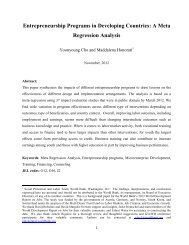STATE OF THE FIELD IN YOUTH ECONOMIC OPPORTUNITIES
STATE OF THE FIELD IN YOUTH ECONOMIC OPPORTUNITIES
STATE OF THE FIELD IN YOUTH ECONOMIC OPPORTUNITIES
Create successful ePaper yourself
Turn your PDF publications into a flip-book with our unique Google optimized e-Paper software.
Table of Contents<br />
Chapter 9<br />
Chapter 1 Chapter 2 Chapter 3 Chapter 4 Chapter 5 Chapter 6 Chapter 7 Chapter 8<br />
Chapter 10 Chapter 11 Chapter 12 Chapter 13 Chapter 14 Chapter 15 Annexes<br />
2012 State of the Field in Youth Economic Opportunities<br />
7 Asset-Based Approaches: Building and Protecting Assets for AGYW<br />
Chapter 7: Asset-Based Approaches:<br />
Building and Protecting Assets of AGYW<br />
Asset-based approaches simultaneously reduce vulnerability and increase young people’s access to<br />
opportunities. 38 While asset-building works for all young people, it is particularly important for adolescent girls<br />
and young women (AGYW). In the name of “building culture” and claims of protection, adolescent girls are<br />
often deprived of what they need to prepare for decent livelihood–they often face social isolation and unrealistic<br />
or inactive economic identity, they are often not afforded meaningful skills building in the financial literacy, and<br />
they often are not able to obtain initial savings experience. It is striking that even girls who complete secondary<br />
school and enter the workforce influence their livelihoods at a much lower rate than males with the same<br />
educational background.<br />
At the 2011 GYEOC, presenters discussed how to both build and protect assets (see Box 7.1.1 for concrete<br />
examples). Recent research and practical experience on gender, employment, entrepreneurship, and legal<br />
codes illuminate the vulnerability of AGYW’s assets and steps YEO programs can take to ensure that girls’ assets<br />
continue to develop.<br />
• Economic empowerment is not enough. AGYW need more than economic opportunities to<br />
make a productive, healthy and safe transition from childhood to adulthood; economic opportunities<br />
also have the potential to increase girls’ exposure to sexual harassment and violence. Karen Austrian,<br />
Associate of the Population Council 39 , highlighted that a program that builds girls’ social, health,<br />
and economic assets can increase girls’ financial literacy, savings activity, and use of formal financial<br />
services, in addition to increasing her self-esteem, social networks, savings behavior, and health<br />
knowledge and behavior.<br />
• Pay attention to timing. Invest in girls early, when puberty changes AGYW’s roles in family and<br />
society, and provide additional support and legal guidance at critical moments of transition such as<br />
marriage.<br />
• Asset-building should be developmentally appropriate. Girls need different social, financial,<br />
and developmental assets at different periods in their life. For example, savings products are more<br />
important when girls are young so they can learn the discipline of savings before they enter into a<br />
lending relationship.<br />
• Analyze who or what threatens AGYW assets. Building assets, particularly the developmental<br />
assets AGYW need to be successful and resilient individuals, is critical. However, it is not enough<br />
to simply prepare AGYW to participate economically as they also need an active plan to address<br />
inevitable efforts to control their income and assets by parents/male partners, sexual threats and<br />
harassment in the workplace, property rights limited unjustly by law or unenforced; these are just<br />
a few ways that economically prepared girls can lose financial assets. YEO programs must make<br />
explicit plans to help AGWY keep their assets. You need a “shark repellent” plan in place with the<br />
understanding that once you give an asset to a girl, someone will try to take it away. 40<br />
38 Adolescent Livelihoods Report: Essential Questions, Essential Tools; A Report on a Workshop. The Population Council. 2004. Accessible at: www.<br />
popcouncil.org/pdfs/adoles.pdf<br />
39 The Population Council is an international, nonprofit organization that conducts research on three fronts: biomedical, social science, and public health.<br />
40 Judith Bruce, Senior Associate and Policy Analyst, Population Council. Excerpt from remarks at Making Cents International’s 2011 Global Youth<br />
Economic Opportunities Conference.<br />
82

















